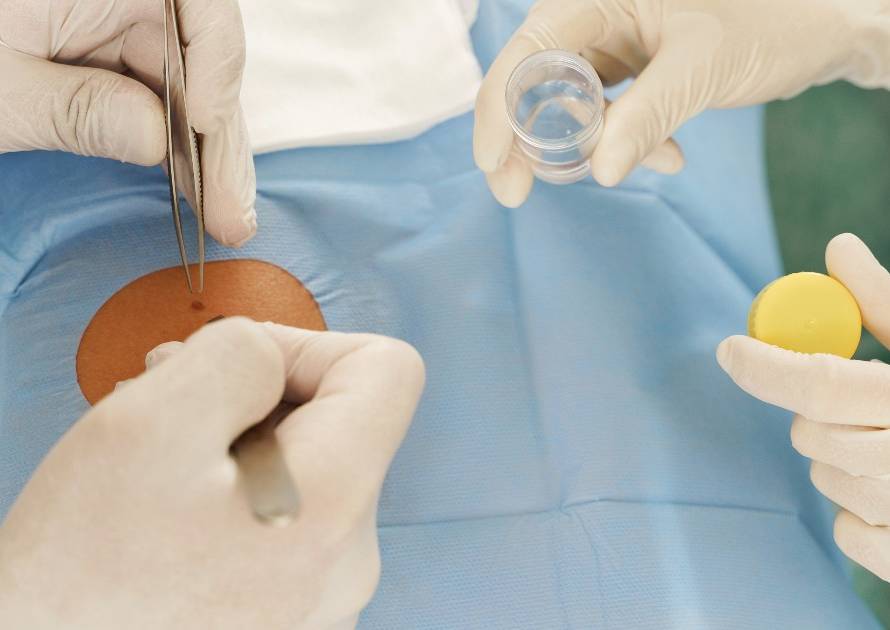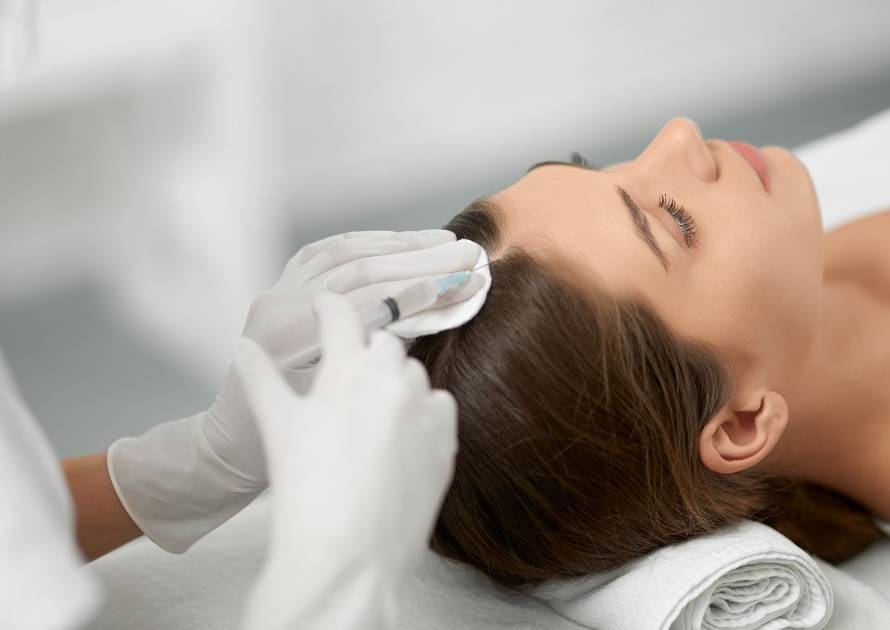Our face has four major components that make its structure. Those components are skin, fat, muscle, and bone. As we age, we lose volume in these structures, which contributes to many of the visible signs of aging, like fine lines and wrinkles.
Moreover, as we grow older, we lose volume in the bones of our face, which can lead to withdrawal of the jawline, descent of the nose, and loss of high cheekbones, which gives the aged face look. Our facial muscles also lose volume and elasticity, and our face fat deflates and moves from its place, which accentuates signs of aging. In addition, our skin stretches and loses elasticity. All of this leads to signs of aging like wrinkles, sagging skin, fine lines, and more.
However, luckily, there is a solution to all of these aging issues—dermal fillers. Dermal fillers are injectable material treatments that are performed in the doctor’s office to help replenish and restore the skin’s volume smoothness, improve the overall facial structure, and correct asymmetry.
Dermal fillers, an injectable treatment performed in a doctor’s office, can help smooth lines and replenish lost volume, restoring a more youthful appearance.
What Are Dermal Fillers?
Dermal fillers are gel-like substances that are injected under different levels of the skin. They are meant to create a more replenished, fuller, and smoother appearance.
Over the years, many types of fillers have been used to fix the skin’s aging appearance. However, nowadays, the most used variety of fillers are synthetic hyaluronic acid fillers. The particles of this type of filler are cross-linked, which gives the skin volume. Moreover, a lot of these fillers are combined with lidocaine to minimize pain during the injection process.
Types of Dermal Fillers
Temporary fillers usually include one of the following materials:
- Hyaluronic acid: Natural substance that is found in the fluids in the eyes and joints.
- Calcium hydroxylapatite: A naturally occurring mineral form of calcium apatite that is found in the bones.
- Poly-L-lactic acid (PLLA) is a biodegradable, synthetic material. It is made of thermoplastic polyester with a backbone formula.
All of the dermal filler types mentioned above are approved and cleared by the FDA (Food and Drug Administration). The only kind of dermal filler that is not approved by the FDA are fillers made with PMMA (polymethylmethacrylate) beads suspended in a solution that contains bovine collagen. The body cannot absorb this type of filler.
Where Can Dermal Fillers Be Injected?
Fillers can be injected anywhere in the face, including:
- Cheeks
- Temples
- Nasolabial folds
- Lips
- The area under the eyes
- The chin
- Jaw angles and jawline
- Marionette lines
- Around the mouth and smoker lines
- Non-surgical nose jobs
- Static wrinkles in the glabella and forehead
Pretreatment Doctor’s Instructions
Here are some of the instructions that our doctor recommends you do before going to the treatment session:
- Keep calm and stay relaxed.
- Eat a full and healthy breakfast.
- Avoid taking any blood thinners like (aspirin, warfarin, multi-vitamins, garlic, etc.) one week prior to your filler treatment session.
- If you have an important event, like a wedding, coming up, do your fillers at least two weeks prior to the event.
- You can use topical anesthetic creams 20-30 minutes before the session.
What to Expect During the Procedure?
Filler injection is a simple and easy process that will only take a few minutes to be done. Here is what you can expect to happen during the treatment session:
- The doctor will first clean the area that will be treated with alcohol to disinfect it.
- The doctor will start injecting the area treated with a needle or a cannula.
- The doctor will do compression if needed.
- The doctor will massage the treated area after the injections.
Instructions to Follow After the Procedure
Here are some of the instructions and guidelines that the doctor recommends you follow right after the treatment session:
- Try to avoid messaging the treated area.
- Do not apply makeup for at least 24 hours after the treatment.
- Avoid going to the gym or exercising on the same day as filler, which will increase the risk of bruises.
- Drink plenty of water.
Due to swelling, the immediate results of filler change in the few days following the treatment. You need to wait for 14 days before the touch-up visit to the doctor to see the final result of your filler injection.
Labels of Dermal Filler that We Use in the Clinic
The following labels of fillers are used regularly in our clinic to give the best results and satisfaction for our clients.
- Juvederm: VOLUMA, VOLBELLA, Volux.
- Restylane: Restylane Lyft, Restylane Refyne, Restylane Defyne, Restylane Kysse.
- Fillmed: Volume, Universal, Fine Line.
- Teoxane: Ultradeep, Kiss, RHA 3, RHA 4.
With all of These Types of Dermal Filler, Which One Is the Best for Me?
Each filler type has its own characteristics, how much volume it will give, how thick it is, and how much water it attracts. Our clinic has the best dermal fillers in the world, and our doctor will choose the best suitable filler for you.
In order for you to know which type of filler fits you best, you need to consult the doctor at the clinic. She will examine your skin, and then tell you which type of filler is best for your skin condition.
How Long Do Dermal Fillers Last?
Usually, all fillers last from 6 months to 2 years. Even after the filler gets metabolized, there will be remaining residual material in the skin, so patients will need a lot of time to go back to the baseline look of their skin. However, the denser the filler is, the deeper it is injected (for example, over the bone), the longer it will last.
The overall duration of resorption depends on many factors, including:
- Type of filler used and its characteristics.
- The treated area: Lip fillers usually fade faster because the lips move a lot, and the filler gets metabolized more quickly.
- Patients’ metabolic rate, is affected by many things, including age, gender, diet, medical condition, lifestyle, and exercise rate.
- Usually, the first filler injection dissolves faster, so the filler will last longer with recurrent injections.
How Can I Know if I Need Fillers and Where It Should Be Injected?
You can only know the answer to these questions by visiting the doctor. The dermatologist will assess your concerns and evaluate your face condition. Once she’s done with her examination, she will let you know the best type of treatment that your skin needs.
The purpose behind dermal fillers is to make your skin look younger, healthier, more fresh, relaxed, and elastic.
Side Effects of Dermal Fillers
There are two types of side effects that patients can face after getting dermal filler injections treatment; acute and long-term. Here is all that you need to know about both types:
Acute side effects:
The following are the acute side effects that the patient might face due to dermal fillers injections:
- Vascular accident due to incorrect entry of the filler to a blood vessel. This usually happens during injection or seconds after; the patient will feel extreme pain, with a change in color in the area. This occurs more often in danger areas and with a fast injection of a big amount of filler using a needle. This type of complication must be treated immediately by injecting hyaluronidase to dissolve the filler clot and restore circulation. Any delay in the treatment might lead to permanent skin damage and scarring.
- Bleeding and hematoma which is usually managed by compression and avoidance of blood thinners prior to injection.
- Infection happens in the first few days after the injection in the form of swelling, redness, pain, and sometimes pustules. It needs to be treated with antibiotics and sometimes hyaluronidase injection to dissolve the filler.
- Bruises: This is the most common side effect; however, it usually subsides within a few days up to 2 weeks. The use of arnica creams makes it fade faster.
- Blindness: This is an extremely rare complication. It happens when the filler’s clot travels inside a vessel and through connections travels to the retinal artery, which causes immediate and permanent loss of vision in the eye if not treated properly and instantly.
Long-term side effects:
The following are some of the most common long-term side effects that could occur after the filler injection treatment:
- Swelling: Mostly happens when injecting a thick type of filler superficially.
- Tyndall phenomenon: This results in blue color in the under-eye filler when injected superficially.
- Biofilm: This is a long-term infection that appears after many years following the filler injection.
- Granuloma: These are nodules in the area of the previous filler injection.
How to Avoid Filler Complications
You can avoid any filler complications by choosing to visit an experienced doctor who is aware of facial anatomy and filler characteristics. Usually, doctors of dermatology, plastic surgeons, and maxillofacial dentist surgeons are the ones who get the best type of proper training for over at least 12 years of preparation in order for them to be able to inject fillers correctly.
Your experienced doctor will guarantee you a low chance of complications happening. However, even if complications occur for some reason, the doctor will be able to treat them and prevent long-term consequences from happening.
This is why you need to always do your fillers in a clean clinic or hospital setting by an experienced doctor.
Frequently Asked Questions About Dermal Fillers (FAQs)
The following are some of the most commonly and frequently asked questions regarding dermal fillers.
Is there downtime after fillers?
This differs from the type of filler. However, most fillers have no downtime. Make sure to ask your dermatologist whether or not you need downtime after the procedure.
When will I see results after getting a filler?
This also depends on the type of filler. Most fillers produce immediate, or almost immediate, results. In the long run, fillers can help your body produce more collagen.
Will I look natural?
Yes, if you want to get a natural-looking face, you need to make sure that the person injecting the filler has expertise in placing the filler. Dermatologists usually recommend that you do not overdo fillers.
When is it safe to get another treatment?
If you recently got a temporary filler, you can usually have another treatment when the signs of aging reappear.”
Are dermal fillers safe?
Yes, derma fillers are 100% safe. Our clinic usually uses natural substances that cause no irritation, like hyaluronic acid. Hyaluronic acid (HA) is a substance that occurs naturally in the cells of the skin thus there is no risk of allergic reactions.



